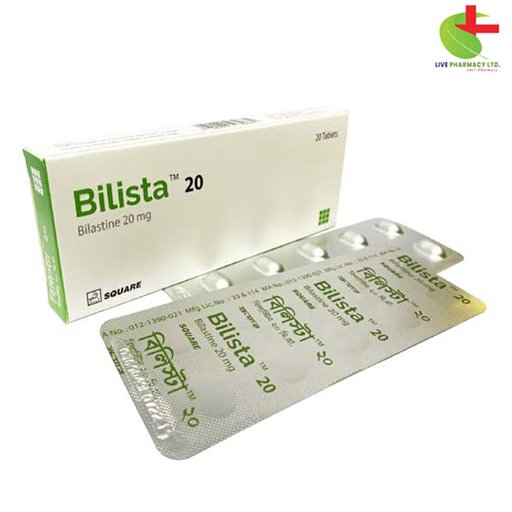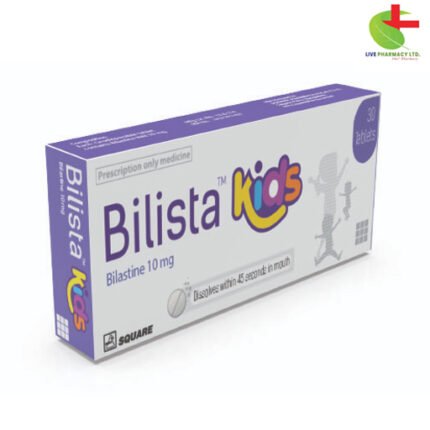Bilista 20
150.00৳ Strip
- Find relief from allergy symptoms with Bilista 20 mg Tablet.
- This non-sedating antihistamine treats allergic rhinoconjunctivitis, urticaria, and hay fever symptoms.
- Featuring Bilastine, its potent formula offers long-lasting relief without causing drowsiness.
- Trust Bilista for comprehensive allergy management and reclaim your comfort.
 Brand
Brand
|
Square Pharmaceuticals PLC |
|---|---|
 Generics
Generics
|
Bilastine |
Indications
Bilista serves as a remedy for:
- Allergic rhinoconjunctivitis, whether seasonal or perennial.
- Urticaria. Moreover, it alleviates hay fever symptoms, including sneezing, itchiness, nasal congestion, and red, watery eyes.
Pharmacology
Bilastine, a potent non-sedating histamine antagonist, exhibits high affinity and selectivity for the H1 receptor, surpassing Cetirizine by threefold and Fexofenadine by fivefold. It demonstrates a remarkable safety profile and favorable pharmacokinetics, devoid of significant interactions with other receptors or histamine subtypes. Bilastine’s metabolism isn’t required for activation, and it’s primarily eliminated through feces (non-systemically) and urine (systemically).
Dosage & Administration
For adults and adolescents aged 12 and above, a single daily intake of a 20 mg tablet provides relief from allergic rhinitis, urticaria, and allergic rhinoconjunctivitis. Children aged 6 to 11 can benefit from a 10 mg mouth dissolving tablet once daily. For children between 2 to 11 years, a 4 ml dosage is recommended daily.
Interaction
Bilista’s co-administration with certain medications like ketoconazole or erythromycin may elevate its concentration, without compromising safety. However, combining it with alcohol demonstrates similar psychomotor effects to alcohol alone. Notably, Bilista doesn’t potentiate the CNS depressant effects of lorazepam.
Contraindications
Patients with hypersensitivity to Bilastine or any of its tablet components should avoid its usage.
Side Effects
Common side effects reported in clinical trials include headache, dizziness, somnolence, and fatigue, occurring at similar rates to those on placebo.
Pregnancy & Lactation
While limited data exist on Bilastine’s use during pregnancy, animal studies haven’t indicated direct or indirect harm. Caution is advised, and breastfeeding mothers should consider the medication’s benefits against potential risks.
Precautions & Warnings
Although Bilista 20 mg doesn’t impair driving performance in most cases, some individuals may experience rare instances of drowsiness. Elderly patients (≥65 years) exhibit comparable efficacy and safety to younger counterparts. No dosage adjustments are necessary for patients with renal impairment.
Use in Special Populations
Bilista’s efficacy and safety in children under 2 years old haven’t been established. Limited clinical experience exists for those aged 2 to 5 years, thus caution is advised.
Overdose Effects
Clinical trials indicate increased frequency of adverse events with doses exceeding therapeutic levels, primarily manifesting as dizziness, headache, and nausea, without serious complications.
Therapeutic Class
Bilista belongs to the category of non-sedating antihistamines.
Storage Conditions
Ensure storage below 30°C, shielded from light and moisture, and away from children’s reach.
Chemical Structure
Molecular Formula: C28H37N3O3. Refer to the provided chemical structure for Bilastine.
Common Questions about Bilista 20 mg Tablet
- Bilista 20 mg Tablet functions as an H1 receptor antagonist, commonly used for treating allergic rhinoconjunctivitis and urticaria.
- Pregnant or breastfeeding individuals should consult a doctor before using Bilista 20 mg Tablet.
- Excessive alcohol consumption should be avoided while on Bilista 20 mg Tablet.
- Patients with kidney diseases should seek medical advice regarding dose adjustments.
- For individuals with liver impairment, consultation is necessary to determine the need for dose adjustments.
Quick Tips
- Bilista 20 mg Tablet is prescribed to alleviate allergy symptoms such as itching, swelling, and rashes.
- Unlike some alternatives, it’s less likely to induce drowsiness.
- Caution is advised while driving or engaging in concentration-demanding activities due to possible dizziness and sleepiness.
- Avoid alcohol consumption alongside Bilista 20 mg Tablet to prevent increased drowsiness.
- Discontinue Bilista 20 mg Tablet at least three days prior to allergy testing to avoid interference with results.













Reviews
There are no reviews yet.